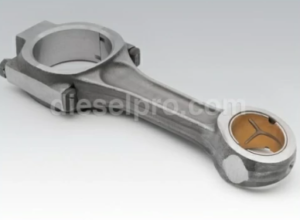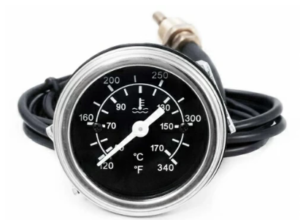Introduction
In the demanding world of marine propulsion, diesel engines from Detroit Diesel, Cummins, and Caterpillar are renowned for their durability and power. Yet even the most robust engines are vulnerable to internal wear, and few components are more critical—or more prone to catastrophic failure—than connecting rod bearings.
These bearings are essential to smooth internal operation, and their failure can lead to engine knocking, power loss, metal shavings in the oil, or total engine seizure. In the marine environment, where engines operate under near-constant loads, failures can be not only costly but dangerous.
This guide examines in depth why connecting rod bearings fail in marine diesel engines, with a dedicated focus on the marine-specific applications of Detroit Diesel, Cummins, and Caterpillar engines. We’ll explore the mechanics of bearing operation, causes of failure, early warning signs, and solutions to prevent recurrence.
The Role of Connecting Rod Bearings in Marine Diesel Engines

Connecting rod bearings sit at the intersection between the crankshaft and connecting rods, and their job is deceptively simple: reduce friction and support the crankshaft’s high-speed rotation while absorbing extreme combustion forces.
In marine diesel engines, especially those used in commercial boats, tugboats, and fishing vessels, these bearings experience:
-
High torque loads over extended periods
-
Elevated temperatures due to confined engine rooms
-
Continuous exposure to contaminants like salt, moisture, and soot
Their hydrodynamic lubrication film must remain intact to prevent metal-on-metal contact. When it fails—even momentarily—the consequences escalate quickly.
How Marine Operation Accelerates Bearing Stress

Unlike truck or stationary industrial engines, marine engines rarely rest. Tugboats, for example, idle under load while pushing, then rev up without the luxury of gradual acceleration. Similarly, fishing vessels start and stop under heavy loads depending on tides or trawling schedules. These patterns create unique stresses, such as:
-
Repeated thermal cycling
-
Constant exposure to moisture
-
Accelerated wear from idle-to-full-load cycles
-
Higher crankcase pressures in confined engine rooms
All these variables impact oil pressure, viscosity, and bearing wear, especially if service intervals aren’t tightly maintained.
Common Causes of Bearing Failure in Marine Diesel Engines

Inadequate Lubrication
This is by far the most common cause of connecting rod bearing failure across all engine platforms.
-
Low oil pressure starves the bearing of lubrication.
-
Oil breakdown from overheating or contamination prevents the formation of a protective oil film.
-
Incorrect oil viscosity (especially during cold starts or when using non-marine-rated oils) can cause dry starts or shear failure.
Detroit Diesel Series 71 and 92 marine engines, for example, use high oil pressures to sustain bearing lubrication. A failing oil pump or clogged strainer quickly creates conditions ripe for bearing failure.
Contaminated Oil
Marine engines are highly susceptible to oil contamination. Saltwater, fuel dilution, and soot can all compromise oil integrity.
-
Salt intrusion (via failed coolers or gasket breaches) leads to rapid corrosion of bearing surfaces.
-
Diesel fuel dilution (from over-idling or injector leaks) thins the oil and breaks down its film strength.
-
Soot and carbon buildup clog oil passages and create abrasive slurry within the lubrication system.
Cummins marine engines like the 6CTA 8.3L and KTA19 are particularly sensitive to oil cleanliness, relying on narrow oil passageways and precise tolerances.
Improper Engine Rebuilds or Assembly Errors
Bearing failures often trace back to rebuild errors:
-
Incorrect torque specs on rod bolts
-
Improper bearing clearances during assembly
-
Non-OEM-quality bearings used in high-load marine applications
Caterpillar’s 3406 and 3500 series marine engines, for instance, are extremely sensitive to connecting rod side clearances and bolt stretch. Missing a spec by even a few thousandths of an inch can lead to premature bearing wear.
Hydrodynamic Oil Film Collapse
Hydrodynamic lubrication only works if oil viscosity, pressure, and surface speeds are in balance. If the engine is run under excessive load or oil pressure drops, the oil film can collapse.
-
Overloading the engine at low RPMs
-
Running in hot tropical waters without proper oil cooling
-
Sustained idling without full oil pressure buildup
Detroit Diesel engines are particularly vulnerable when operated with degraded oil or coolant temps exceeding the design limit. Series 60 marine variants also suffer from oil film collapse if the crankcase is over-pressurized or breather systems are blocked.
Debris and Foreign Material
Any debris introduced into the oil system—be it from a failed turbo, worn piston rings, or improper shop procedures—can scratch or score the bearing surface. These micro-abrasions develop into hotspots, which cause localized oil film breakdown and eventual failure.
If you’re rebuilding a Cummins KTA50 marine engine and do not flush out the oil cooler and galleries thoroughly, leftover debris from the teardown can trigger an early bearing failure.
Warning Signs of Bearing Failure in Marine Engines

Knowing how to recognize early signs of bearing distress can prevent engine loss.
Low or Fluctuating Oil Pressure
Bearings are the primary consumers of oil pressure. If pressure drops without obvious leaks, it may indicate internal bearing clearance widening.
Metallic Knocking or Thudding Sound
Rod knock is often the death rattle of a bearing. The deeper and duller the knock, the more likely it is that a bearing has spun or worn through its overlay.
Oil Analysis Reveals Elevated Metal Particles
Look for spikes in:
-
Lead (used in bearing overlays)
-
Copper (bearing backing)
-
Tin and aluminum (alloys)
Routine oil analysis, especially in Cummins or Detroit Diesel marine fleets, is an invaluable tool.
Overheating and Loss of Power
Friction increases as bearings fail. Engines may run hotter, struggle under load, or lose RPM capability. A misfire or poor combustion may also result from bearing-to-crank misalignment.
Case Studies: Real-World Failures in Key Marine Diesel Platforms

Detroit Diesel 6-71 and 8V92 Marine Engines
These 2-stroke engines are legendary in the marine world but are sensitive to oil cleanliness and cooling issues. Failure scenarios often include:
-
Spun bearings due to clogged oil coolers
-
Overlay flaking from high sulfur fuels before ULSD became standard
-
Bearing crush loss from improperly torqued connecting rods during rebuilds
These engines must be rebuilt with precise bearing torque specs and attention to thrust bearing endplay. Using aftermarket bearings without proper metal composition can accelerate failure.
Cummins 6CTA 8.3 and KTA19/KTA38
Cummins marine engines depend on clean, pressurized oil and correct CPL-matched parts. Typical failure issues:
-
Fuel-diluted oil causing lubrication loss
-
Wrong bearings for CPL number, especially in gray-market rebuilds
-
Tight bearing clearances leading to thermal scuffing under marine loads
High-horsepower applications, especially in sport fishing and commercial workboats, must match bearings to CPL specs and check bore roundness on every rebuild.
Caterpillar 3406 and 3500 Marine Engines
Caterpillar engines are built to last, but improper rebuilds or extreme marine conditions still take a toll:
-
Undersized journals reused without machining cause poor oil wedge formation
-
Rod bolt stretch not checked, especially during hot engine disassembly
-
Bearings installed backwards (with tangs mismatched) leading to instant failure
The 3406 in particular has a long rod and high compression ratio, so even minor bearing misalignment leads to rapid fatigue under load.
Preventing Connecting Rod Bearing Failures

Follow OEM or Aftermarket Specifications Precisely
For Cummins, Caterpillar, and Detroit Diesel marine engines, precision matters. Always:
-
Use high-quality aftermarket bearings with proven metallurgy
-
Check and record bearing clearances with plastigauge or micrometers
-
Use torque-angle methods or stretch gauges when tightening rod bolts
Avoid generic rebuild kits that aren’t verified against the engine’s CPL or family code.
Maintain Oil Quality and Change Intervals
For marine diesels:
-
Use high-TBN marine-grade oil
-
Change oil based on hours, not calendar time
-
Analyze oil every 250–500 hours
Install bypass filtration if extended drains are desired.
Install Oil Pressure and Temperature Alarms
A $200 sensor can save a $20,000 engine. Alarm thresholds should be set conservatively:
-
Oil pressure < 20 PSI at idle or < 40 PSI under load = shutdown trigger
-
Oil temp > 230°F = alarm condition
These are especially important in Detroit Diesel Series 92 engines, where overheating combined with low oil flow is a recipe for bearing death.
Use a Proper Break-In Procedure
Improper break-in is a leading cause of early bearing failure in rebuilds. Marine diesels need:
-
Light to moderate load for the first 25–50 hours
-
Controlled oil and coolant temperatures
-
Proper ring seating before going to full throttle
Avoid high idle for long periods—especially common in harbor operations—until full break-in is complete.
The Aftermath: What Happens When Bearings Fail?
Spun Bearings
A spun bearing rotates within the rod cap or housing, wiping out the bearing surface and blocking oil flow. This leads to:
-
Crankshaft journal damage
-
Heat discoloration
-
Debris in the oiling system
-
Full engine teardown
Thrust Bearing Failure
If a rod bearing fails, crankshaft end play may also increase, causing damage to thrust washers or flanges. This is particularly common in inline Cummins marine engines, where the thrust bearing is built into the main bearing system.
Crankshaft Damage
Severe bearing failure leads to:
-
Journal scoring
-
Out-of-round conditions
-
Hot spots and heat cracks
Crankshafts must be ground or replaced. In Caterpillar engines, this often makes rebuilding uneconomical.
Expert Tips for Marine Diesel Technicians
-
Always clean oil galleries with rifle brushes after bearing failure
-
Replace rod bolts after every rebuild—they stretch permanently
-
Match bearing material to application: tri-metal bearings handle higher loads, while bi-metal bearings may last longer in steady-state operation
-
Check for bent rods, especially after a hydrolock event—this causes side loading on bearings
-
Monitor alignment during rebuilds, especially in inline engines
Final Thoughts
Connecting rod bearings are the heartbeat of your marine diesel engine. In Detroit Diesel, Cummins, and Caterpillarplatforms, their failure typically stems from one of three things: poor lubrication, incorrect rebuild practices, or operating conditions that exceed design tolerances.
By proactively maintaining oil quality, using OEM-matching aftermarket components, and following correct assembly practices, you can greatly extend the lifespan of these critical components—even in the harshest marine environments.
When in doubt, rely on precise data—oil analysis, clearances, torque specs—and stay ahead of the problem. A healthy bearing means a reliable engine, and in marine operations, reliability isn’t optional—it’s the foundation of every successful voyage.



 Free US Calls: 1-888-433-4735
Free US Calls: 1-888-433-4735 International: 305-545-5588
International: 305-545-5588